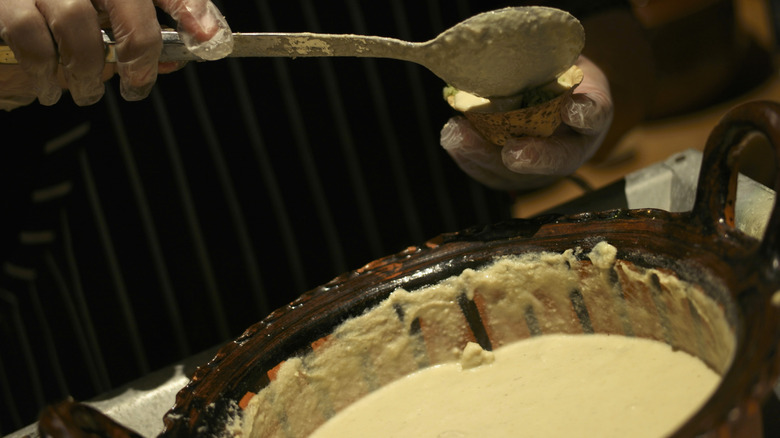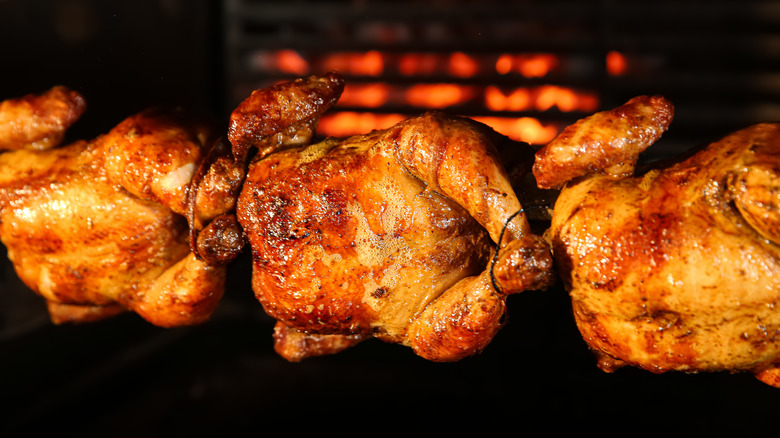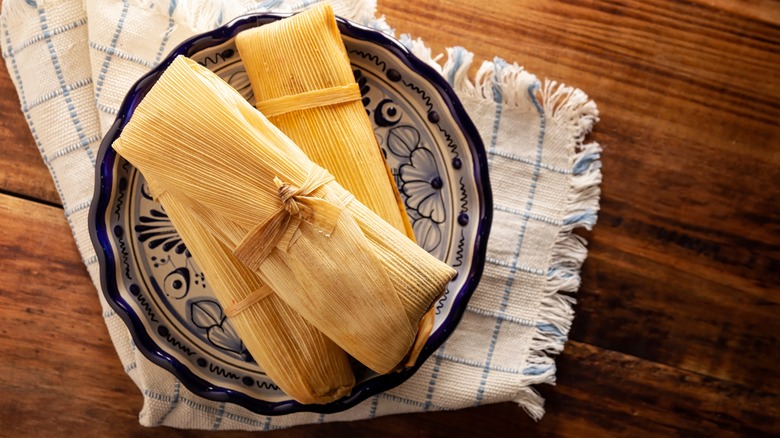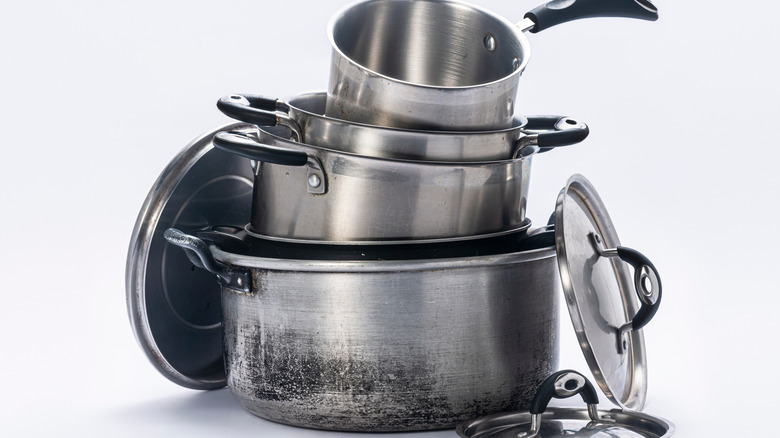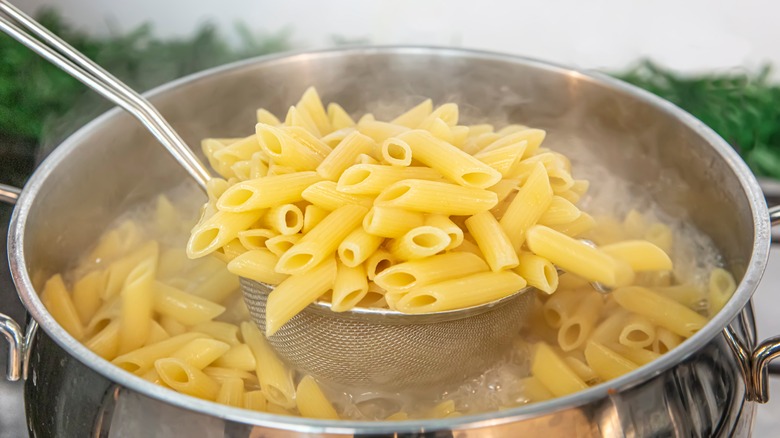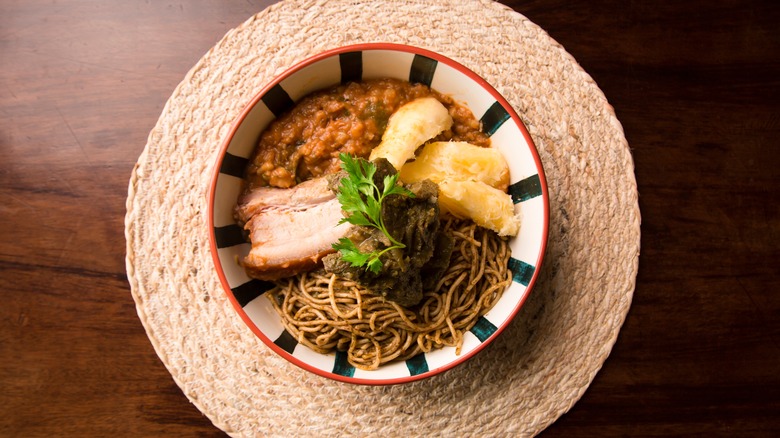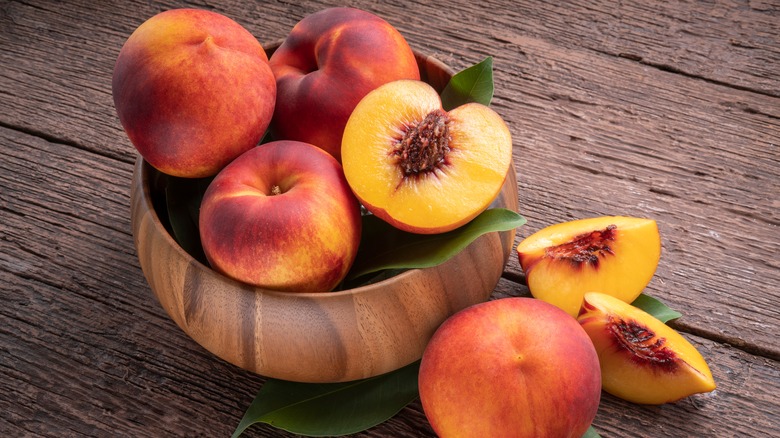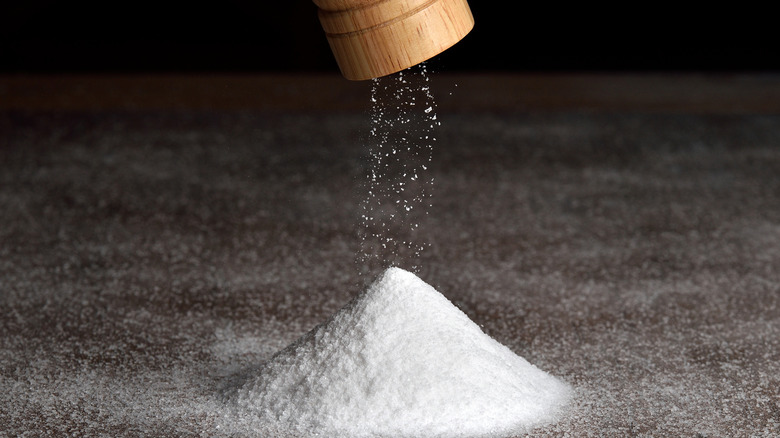Rick Martínez Reveals What He Is Cooking At The New York Times Food Festival - Exclusive Interview
No one knows Mexican cuisine quite like Rick Martínez. That's why he's headed to the New York Times Food Festival – to give you his best tips and tricks on cooking Mexican food. You may recognize Martínez from Food52's YouTube channel, in which he shares his latest recipes. The cookbook author has even contributed to the New York Times, so it's only fitting that he visits one of the most exciting food festivals of the year.
In an exclusive interview with Mashed, Martínez divulged his innermost cooking secrets along with what recipe he is making at the festival. The culinary workshop host is set up to do a mole demo with food columnist, Melissa Clark. While Martínez mentioned he is excited to see his friends and the headliners of the festival (like Ina Garten), he also did a deep dive into his favorite one pot meal. If you're making pasta tonight, don't fret: The food connoisseur has some major tips for that, too.
The dish Martínez is demoing at the festival
The food festival is coming up next week with the New York Times. I saw that you were hosting a mole demo from your cookbook. Can you tell me what inspired this recipe?
Moles are a mother sauce in Mexico, and they're one of the most important elements of Mexican cuisine. Unfortunately, it's actually pretty difficult in the US to get a good mole, so a lot of people think of moles as either being too sweet or too chocolatey or misunderstood or too difficult to make. It was something that needed to be in the book to represent the country in the cuisine.
Also, I wanted to demonstrate that it's actually not as difficult as it might seem. I wanted to get people to look at a couple of different types of mole and show that they're not all super sweet, they're not all chocolatey, they're not even all brown or black. I have a Mole Blanco, which is a white mole. I have a Mole Amarillo, which is a yellow mole, and then I have the Mole Coloradito, which is a reddish brown mole in that cookbook.
Are you doing all three for the festival or just one of those?
I'm going to demo one. I'm going to have all three on set as a reference and talk about the different types and styles, but I'll be demoing the Mole Coloradito.
Is there a special ingredient that you put in that mole that you could share?
One of the fun ingredients — and again, this was actually new to me until I started traveling around the country — animal crackers are actually commonly used. They serve a couple of purposes: They give a little bit of sweetness, but they also, because they're made up out of wheat flour, they add a little bit of thickening as well. It improves that nice, creamy texture of the finished product.
How Martínez recommends making mole
When I was researching mole, I saw that you could pair it with a lot of different things. What do you recommend pairing your mole with?
I love a good roast chicken or roast turkey, and that's normally what's most commonly used to serve it with. I also think it pairs very well with fish, either steamed or poached. You could potentially even fry it if you wanted to. I've made moles vegan and then served it over roasted vegetables. Roasted fall vegetables are really great.
The way to think of it is almost like a marinara sauce. It's a classic fundamental sauce in Italian cuisine, and you can put it with pasta but you can do a lot of other things with it. It's a very versatile sauce from that perspective.
Say someone is making it for the first time. What would your biggest tip be for them?
Don't get intimidated by the number of ingredients. I have a recipe, called a Mole Sencillo, which is a simple mole. It's a 10-ingredient mole, and I wanted to make it with things that you would have in your pantry so that you wouldn't have to buy anything, like a tomato, an onion, peanuts, pecans, things that are already there. You don't have to shop for anything new. My feeling is that there are some fundamental techniques with how moles are constructed, and if you learn how to do the techniques, you can make a 54-ingredient mole and you'll be totally fine.
You can also have fun with swapping out the different types of ingredients. In the US, we have this perception that there's only one correct way to make a certain dish. If it's not an American food, you think, "Okay, there's only one way to make a soup dumpling in China. There's only one way to make a mole in Mexico." The reality is, if there are 150 million cooks in Mexico, there are 150 million different versions of that dish.
You cook with what you have. You cook with what is easily accessible. You cook with the things that you like to eat. I want people to feel like they should do that. If you learn the basic mole making techniques, then use whatever you have in your pantry. Use the things that are growing fresh in your community. Use the things that you want to eat or that you're craving and then you'll have a mole that's your personal spin on it.
Martínez reveals the most underrated Mexican food and who he's excited to see at the festival
You mentioned a few times that we don't always have authentic mole available in the US. In your opinion, what is the most underrated Mexican food here?
Oh, that's so hard. There are two things that I really love that I don't think exist enough in the US: tamales and tortas. Tamales are probably my favorite food in all of Mexico, and there's not even a particular type that I like. Every single community — tiny little town, big city — has so many different kinds of tamales. It's basically a steamed dumpling. In some cities, they throw them on the grill and they crisp up the outer edges. Some people will fry them afterwards.
There are so many different styles, but they're so good. There's something to me so comforting about a steamed tamale. Most of the time, they're made with corn masa, but I've had them made with rice or other grains and they're also equally delicious. Sometimes they're super savory, sometimes they're sweet and used as a dessert. Americans are aware of tamales, but they probably only think of it as either pork, chicken, or a veg with cheese, and then that's it. There's 100 million different varieties of it.
There are going to be a lot of fun cooking events and some big names at the festival. What are you most excited for?
Oh God, all of it. To be honest, I love live audiences. It's so much fun. One of my best friends in the universe, Eric Kim, is also going to be at the festival. I can't wait to see him. We're having dinner a couple of nights while I'm in the city, but also to be on the same stage — a lot of the people that are going to be at the festival are friends of mine. In a weird way, it's almost like I get to hang out with my friends on a stage, and even though it's a big event, it seems more like a friend reunion.
Have you met Ina Garten before? I know she's going to be there as well.
I have, yeah. When I worked at Bon Appétit, she had been to the kitchen there on several occasions, cooking and making videos. That'll be nice. [There's] also Padma Lakshmi, I'm excited, and then Melissa Clark, I've known for years. We had a call earlier today, and I'm excited to talk to her during the demo.
What Martínez thinks you should make for a dinner party
Say you are having a dinner party for 15 people. What would you make for them?
I have recently made, for the New York Times, a recipe for a taqueria style taco campechano. In Mexico City and other places, at the little taco stands, they have these giant pots. At the beginning of the day or in the morning, the taqueros will put all the different meats that they serve and different vegetables in this pot, and then it slowly simmers all day long.
When you go up and you order your taco, one of the styles that you could order is campechano, which is a little bit of everything. Literally everything is cooking together, so the broth is super flavorful and it has all the flavors. They chop it up, dip your tortilla in the cooking liquid, and throw it on a griddle and toast it up. It's so incredible. I had never attempted that recipe because it always seemed difficult unless you were cooking for a crowd.
I was like, "You know what? I'm going to go ahead and do it. This is going to be an eight to 10-person party dish, and I actually really want to have a party now," so I developed this recipe. It's brisket and chorizo and a pig's foot and some pork belly and onions and garlic and chiles. You basically throw everything in the pot and let it simmer. You do exactly what the taqueros do. I've had parties and taco parties before and everybody always stands around, and I love that.
Do you have any specific tips on how you would go about making that? Throw it all in the pot?
It's literally a one pot meal. The way that I wrote the recipe is, you can make straight up tacos, put the meat out and put it in a tortilla and eat it, or, I explain how to do it like the taqueros, which is: You cut up the meat and put it in a bowl, mix it with a little bit of the broth so it gets juicy, and then that becomes your taco filling.
Whatever broth is left, you dip your tortillas in and throw them on the griddle. A lot of the fat will float up to the top in that broth. It's that little layer of fat that is going to help get your tortillas really crispy, but also a lot of flavor.
Martínez gives his best tips for pasta
I saw on your YouTube channel too, with Food52, that you shared recipes for no-cook summer pastas. What is the biggest mistake you think people make with pasta?
Under salting the water. It's so strange to me, because I worked in a restaurant. We had a pasta station and we put a lot of salt in the pasta pot, probably more than most people realized that you need to do. You can actually taste the flavor of the pasta even when there's nothing on it.
Whenever I make pasta for my friends, or even in professional kitchens, I'll get a comment, "Wow, this tastes like pasta from a restaurant." I didn't really understand what that meant until I was like, "It's because people get really shy or afraid of salting their pasta water. You really do need to salt it to the point where the water is almost inedibly salty.
Like seawater?
It's almost stronger than seawater. Seawater is a good indicator, but I feel like it's seawater plus a little bit more. At the restaurant, we used to talk about it as almost like brine strength. It's like 10% of the weight of the water is salt, which is really, really salty. The pasta comes out and it doesn't absorb as much of the salt as you think it's going to absorb. A lot of times, if you under season your pasta, all you taste is the sauce.
If you have a great sauce, then that's fine, but if you have good pasta, then you want to taste it, especially if you're spending money to buy fancy pasta or you're making it on your own. Even a boxed pasta is going to have a decent flavor if you put salt in it.
It's always controversial to salt or not to salt or how much you put in.
The only thing that I'll say is, the only time that I hold back and I'll edit the salt in the pasta water is if I know I'm going to use the pasta water. That's the only time that I'll hold back and I will also hold back salt in the dish.
Like in a sauce or something like that?
Yeah. If I salt it the way I normally do, it's way too salty to use in any kind of sauce. I'll use almost half of what I normally use, and then I'll be able to use the pasta water. Otherwise, it's lots of salt.
The Mexican-influenced pasta Martínez can't get enough of
Do you have a favorite Mexican-influenced pasta dish that you could share?
Oh, yes. It has a couple of different names: Fideo Seco or Sopa Seca. Basically, it's vermicelli, which is a really thin type of spaghetti that's broken into pieces. The way that I like to prepare it is [to] toast it in a dry skillet until it gets really brown and it almost picks up this nutty flavor. Imagine, it's flour, but imagine the difference between a slice of sandwich bread and then a slice of toast. There's a big difference in flavor.
When you toast the pasta, that nutty, toasty flavor is what you're going to be adding to it. I'll add onions and garlic and chili poblanos and tomatoes and sauté that, maybe in a little chicken fat or lard, and then add chicken stock. You let that simmer, kind of like rice, until all the liquid is absorbed. My mom used to make it and she used to put potatoes in it, which I like as well. When you add the potatoes right before you throw in your broth and you cover and simmer it, they'll steam and cook while the pastas are cooking, and it's almost like a full meal.
That sounds delicious. I'm sure didn't it didn't take that long either, right?
No. It's literally making rice. My mom used to use it as a side dish. When I was in college, we ate it as a full meal because it's got vegetables and starch, so it was very filling.
Martínez names the one chef he'd want to cook him dinner
Besides yourself, who is the one chef you would want to cook you dinner?
Oh, that's also really hard. I have a friend in Austin, Texas. I grew up in Austin and my friend Fermín Núñez now has two restaurants where he's [opened] up a new restaurant on Monday, actually, on the third of October. He's a chef and owner of Suerte, which is this amazing Mexican restaurant. He's opening up Este, which is a seafood restaurant.
What I love about his food is that he's making the food that he loves from where he grew up, and he's using traditional techniques, on a restaurant scale, but then he's using local ingredients in central Texas. For example, he has several moles on his menu. He's like, "Almonds and plantains don't grow in central Texas, but what does grow are peaches and pecans."
He's using peaches and pecans in his mole, which [made me think], "That's such a brilliant idea." You're using local ingredients that are going to be really delicious and in season. You're helping local farmers. You're taking something that's very Mexican and giving it a little local spin, which is what Mexican cooks do.
Fresh ingredients make all the difference in food, so that sounds awesome.
100%. He was like, "Why am I going to spend money to have all these plantains shipped from far away, when I can help out local farmers and use peaches?" [They] are going to do the same thing. They're going to add sweetness and acidity to the dish.
Why Martínez can't live without this one ingredient
Is there one ingredient that you feel you just could not live without?
You know what I really love? It's funny, because this is a pretty recent change for me. In professional kitchens, particularly in New York and also in restaurants in New York, everybody uses diamond crystal kosher salt, because it melts really quickly. When you add it to a dish, and then you taste it immediately after, the salt is melted and it's distributed and then you get a sense of how it's going to taste. I never really thought about it or questioned it. It's like, "That's what everybody uses," so that's what you make all our recipes with.
And then I moved here. I live by the ocean. I live in Mazatlán, Mexico. I was like, "I don't want to buy this salt because it was going to cost a lot of money to have it sent here. I live by the ocean. I should use sea salt." It has completely changed the way that I think about food. I've also decided that I'm never going to call for kosher salt in my recipes anymore. People should use sea salt. It's so much more mild. It's also weird when I talk about this, because people are like, "It's salt. It tastes like salt."
Actually, salt has a flavor, and salt has strengths. I find now that kosher salt tastes very, almost astringent to me. It has a very sharp flavor that I can detect in the food, whereas sea salt has a much more soft and round flavor. It's not as aggressive. It still does the job. I can still use four grams, which is a teaspoon of sea salt, and it'll do the same job that a teaspoon of kosher salt does, but I feel like you get a little bit more of the mineral notes and it tastes more earthy. That is one thing that I feel like is permanent now in my kitchen: sea salt.
Do you have any upcoming projects or anything else that you would be able to share with me?
I'm doing "10 Essential Mexican Recipes" for the Times, which I'm really excited about. I'm also doing a Mexican food workshop on the Magnolia Network, which I'm super excited about as well.
Learn more about the New York Times Food Festival on their website. Check out Rick Martínez's website to keep up with his current projects.
This interview has been edited for clarity.

